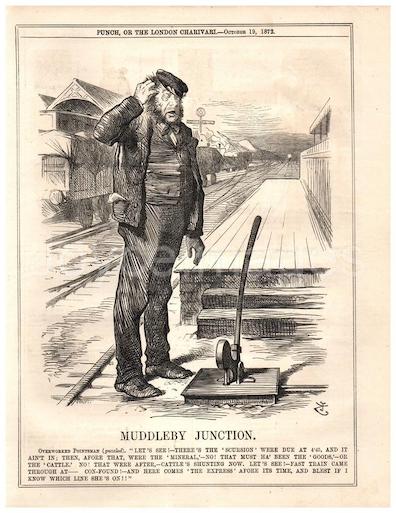As the funeral carriage rolls past Westland Row on Great
Brunswick Street, Bloom notices a sudden vigorous action in
the street: "A pointsman's back straightened itself upright
suddenly against a tramway standard by Mr Bloom's window."
Pointsmen (called switchmen in the U.S.) were railway workers
stationed at track junctions to pull on metal levers that
opened one line or another to oncoming trains. In The
Bloomsday Trams (2009), David Foley observes that "An
example of a standard is now preserved at the national
Transport Museum" (4), which is located inside the main gates
of Howth Castle.
"Points" (sometimes called switch rails, switch points, or
point blades) are pairs of rails, tapered at the ends, that
swing a few inches from side to side to guide train wheels
into either of two sets of fixed rails. They are linked
together to ensure that only one point rests against a fixed
rail at any given time, and often some kind of indicator shows
train drivers which set of tracks is currently open. Today
many of these switches are powered by electric motors or by
pneumatic or hydraulic actuators, but some still require a
human being to shift the points manually, as evidently was the
case in Dublin at the time represented in the novel. In the
1937 photograph displayed here, a pointsman appears to be
manually performing a second function: indicating to a tram
driver which line is open.
Seeing the pointsman's laborious effort, Bloom indulges one
of his fancies about civic improvement: "Couldn't they
invent something automatic so that the wheel itself much
handier? Well but that fellow would lose his job then? Well
but then another fellow would get a job making the new
invention?" The idea that some device might make it
possible for motormen to shift the track's points, eliminating
the need for pointsmen, probably reflects Joyce's awareness of
imminent technological change. The electrification of Dublin's
trams had been completed in 1901, and Foley notes that "Forty
automatic switches were installed at an unspecified date in
1904 and were operated by the driver sending a jolt of current
on to a contact set in the road" (4). These electrical
switches were not activated by a train's "wheel"––the
mechanism that Bloom imagines––but that idea too seems to have
some basis in physical reality. So-called "trailable switches"
allow trains on either of two converging lines (i.e., moving
toward the single set of tracks) to move the points with their
wheels.
Bloom is not simply daydreaming, then. He is applying
technological developments that he has heard of or read about
to the practical business of moving around the city––just as
he will do a bit later later in Hades, when he
suggests that Dublin should have funeral trams as in
Milan. His thoughts about workers losing their jobs and
other kinds of jobs being created is of course a staple of the
modern industrialized economy, often referred to these days as
capitalism's effect of "creative destruction."
Although Joyce does not have Bloom reflect on it, another
kind of economic reality was involved in the job of
"pointsmen." Foley observes that "The tramway company employed
boys" to do this physical labor (4). Slote confirms this
information, quoting from Michael Corcoran's Through
Streets Broad and Narrow: A History of Dublin Trams:
"The pointsmen were frequently boys..., hopefuls for future
employment as motormen or conductors" (70). Corcoran's book
agrees with Foley's also on the installation of electrically
controlled track points: the DUTC experimented with
these new devices in 1903 and installed forty of them in 1904.


